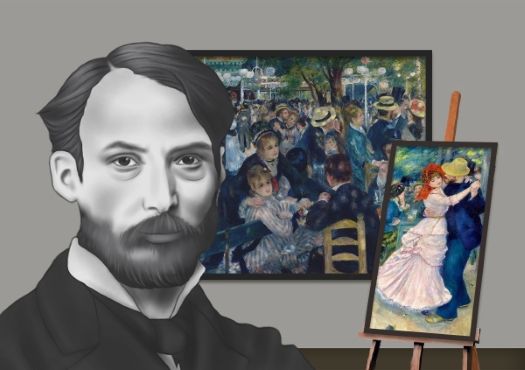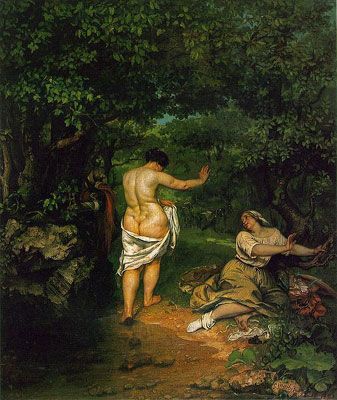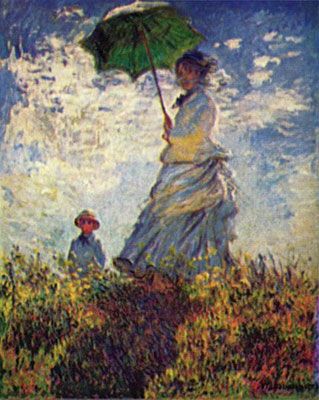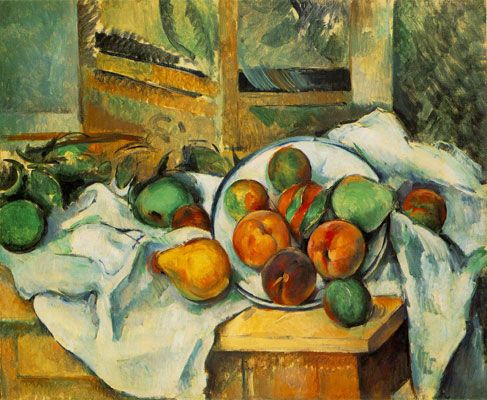Summary of Pierre-Auguste Renoir
Pierre-Auguste Renoir was a French Impressionist painter whose eye for beauty made him one of the movement's most popular practitioners. He is best known for his paintings of bustling Parisian modernity and leisure in the last three decades of the 19th century. Though celebrated as a colorist with a keen eye for capturing the movement of light and shadow, Renoir started to explore Renaissance painting in the middle of his career, which led him to integrate more line and composition into his mature works and create some of his era's most timeless canvases.
Accomplishments
- Working alongside Claude Monet, Renoir was essential to developing Impressionist style in the late 1860s, but there is a decidedly human element to his work that sets him apart. Renoir had a brilliant eye for both intimate domesticity and the day's fashions, and his images of content families and well-dressed Parisian pleasure-seekers created a bridge from Impressionism's more experimental aims to a modern, middle-class art public.
- Renoir was the first Impressionist to perceive the potential limitations of an art based primarily on optical sensation and light effects. Though his discoveries in this field would always remain integral to his art, he reasserted the necessity of composition and underlying structure in modern painting, achieving in his mature work a structured, monumental style that acknowledged the strengths of High Renaissance art.
- Renoir's example became indispensable for the major French movements of high modernism: Fauvism and Cubism. Like Renoir, the progenitors of these styles focused on issues of color, composition, and depth rather than quick sketches of individual moments. His composed, vivid paintings created a vital bridge from earlier colorists like Raphael, Peter Paul Rubens, Jean-Antoine Watteau, and Eugène Delacroix to the 20th-century giants Henri Matisse and Pablo Picasso.
The Life of Pierre-Auguste Renoir
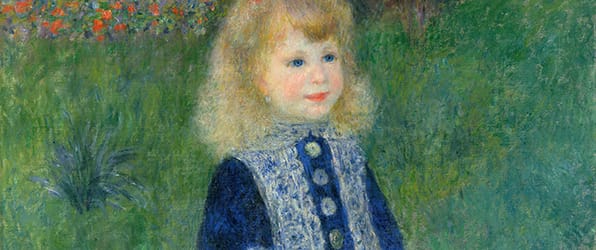
Renoir’s career could be characterized as a roller-coaster of success and rejection, and of connection with and distance from the Impressionist group. But to this day, his art continues to pose the question he once voiced himself: “Why shouldn’t art be pretty? There are enough unpleasant things in this world.”
Important Art by Pierre-Auguste Renoir
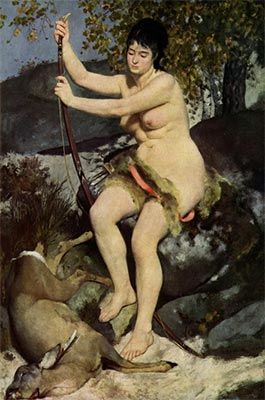
Diana the Huntress
This wonderfully composed piece is far from exemplary when considering Renoir's later body of work. What we see, rather, is a young artist with a gift for oil painting and composition and yet without a truly distinct voice of his own. During his early years, Renoir spent a great deal of time touring the halls of the Louvre and other museums and studying the French masters of the 18th and early-19th centuries. In this canvas, he rendered his mistress Lise Tréhot as the Roman goddess Diana, a common trope in Rococo portraiture. Though the matter-of-fact depiction of a full-figured nude also recalls his love of Realism à la Courbet, he achieves a Classical timelessness that Realism lacked.
Oil on canvas - The National Gallery of Art, Washington DC
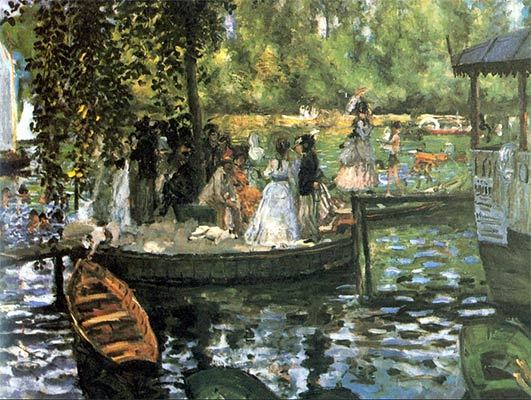
La Grenouillère
At the popular outdoor bathing spot and bar La Grenouillère ("The Frog Pond"), Renoir and Monet, not yet financially successful artists, painted images of middle-class leisure that they hoped to sell to its wealthy clientele. As they worked closely alongside one another, the two simultaneously developed several of the theories, techniques, and practices that would give rise to Impressionism. Both artists painted this scene from this exact vantage point. If Monet's gives a broader perspective and focuses more on the vivid effects of light on the water and surrounding trees, then Renoir's version gives a closer view of the fashionable denizens of the popular resort. Indeed, even when painting nature en plein air, Renoir gave a weight to the human subject perhaps unmatched by his fellow Impressionists.
Oil on canvas - Nationalmuseum, Stockholm
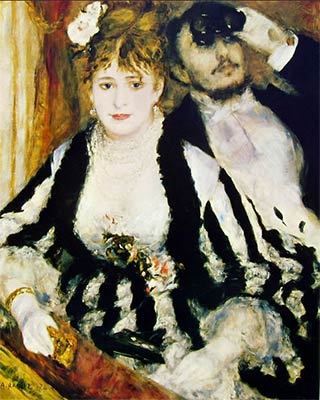
La Loge
Depicting an elegant-looking couple sitting in an elevated theater box, this tribute to Parisian modern life was also the artist's principal contribution to the very first Impressionist exhibition of the same year, and it was met with much acclaim. The theater played a prominent role in Parisian life, from opera to the popular variety shows featuring can-can dancers, and depictions of the theater typically focused on the performers. However, much of the allure of the theater for the middle class was the opportunity to see and be seen, and La Loge deftly captures that complex interplay of gazes. The woman lowers her opera glasses, implying that she is no longer watching the events on stage and allowing her face to be seen. Meanwhile, the man (Renoir's brother Edmond) leans back in his seat, perusing the theatergoers in other balconies through his glasses. With his delicate and masterful rendering of his model's lacy bodice, glinting jewelry, and floral accoutrements, Renoir painted a canvas about seeing that spoke to his own keen eye.
Oil on canvas - The Courtauld Gallery, London
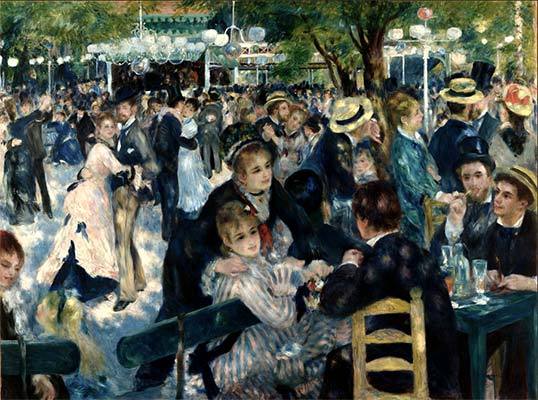
Dance at the Moulin de la Galette
Universally considered among Renoir's masterpieces, Dance at the Moulin de la Galette is a snapshot of everyday life in the fashionable neighborhood of Montmartre. The courtyard of the Moulin de la Galette, still in operation today, was a gathering place for working-class drinking, dining, and dancing. Moulin presented Renoir with a true and unique challenge: the sheer quantity of people, details, and viewpoints to capture, combined with the flickering sunlight and inherent movement that came with such a scene, was an awesome undertaking. His solution was a significantly larger-than-average canvas for an Impressionist painting (over four-by-six feet), in which he unified several vignettes of activity, several couples dancing, a table of friends drinking, and standing groups talking, with colorful brushstrokes that denote zones of shade and light from the canopy of trees overhead.
Oil on canvas - Musée d'Orsay, Paris
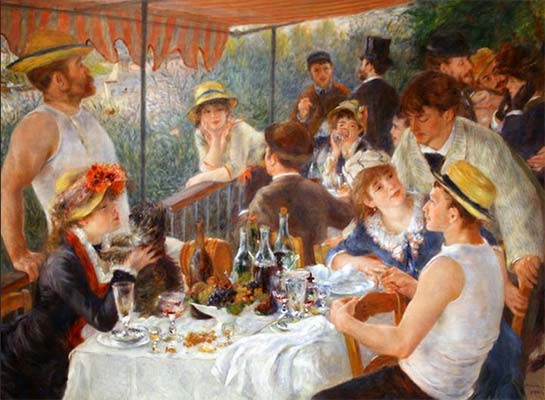
Luncheon of the Boating Party
In Luncheon of the Boating Party, Renoir depicted a number of his close friends, including painters, art dealers, and his future wife Aline Charigot, in a smaller, more intimate setting than in a painting like Dance at the Moulin de la Galette. Though he uses smaller groupings of figures to manage the fourteen partygoers (and one dog), he renders the scene without making it feel staged like a group portrait. Looking beyond the individual subjects of Luncheon, there exists an amount of composition typically foreign to Impressionist canvases. Indeed, in the early 1880s, Renoir began to reintegrate classical notions of composition into his canvases; here, he used the boat's railing to create a diagonal axis from background to foreground, gradually making the scene less congested and more full of patterns of light, shadow, and color. Coupled with his intense study of surface (glass, flesh, straw, various textiles) is a sweetness in the image of Charigot smooching at a toy terrier that is representative of the best of Renoir's work.
Oil on canvas - The Phillips Collection, Washington DC
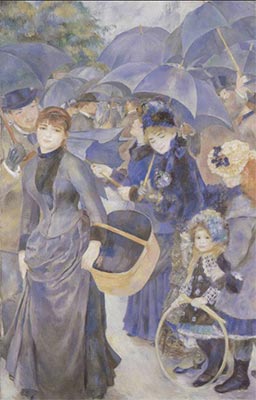
The Umbrellas
Renoir occupies an important place in the history of modern art for being the first to introduce underlying structure into the Impressionist mode of vision. In doing so, he set the stage for the Post-Impressionist Paul Cézanne and for 20th-century movements like Cubism that would deeply analyze form, depth, and perspective in a modern manner. The Umbrellas is a paradigmatic painting in that conversation, as Renoir painted it as an Impressionist canvas in 1881 before reworking it in 1886 with the underpinnings of classical composition he had seen on trips to view Old Master painting in Italy. The finished canvas, then, brings Impressionism's experiments with color and light into cooperation with stronger line and an emphasis on geometric forms, evident in the vivid, brushy trees in the background, the reflections of natural blues and greens onto the dress of the young woman on the left, and the intense interplay of eye contact. The result is a beautifully worked image that captures a temporary moment of being caught in the rain, as a gentleman, presumably taken with the beauty of the young woman, leans in to offer her shelter under his umbrella.
Oil on canvas - The National Gallery, London
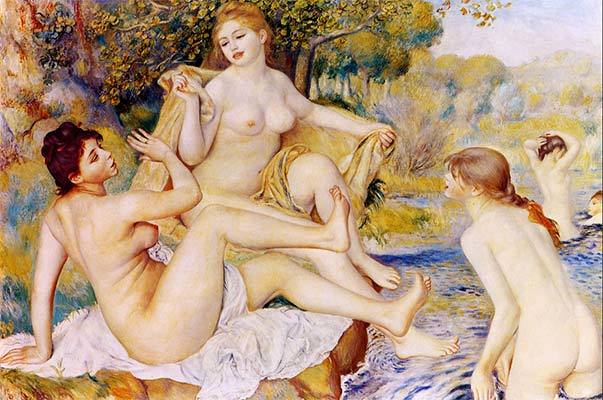
The Large Bathers
Beyond merely attempting to bring Renaissance structure into Impressionism, Renoir also courted the timelessness of classical style by painting traditional subjects. With its focus on coloration and its figural group of three beautiful, robust women at the center, The Large Bathers is reminiscent of Peter Paul Rubens's dynamic step beyond High Renaissance techniques. Renoir painstakingly worked and reworked The Large Bathers for three years, including making several preparatory drawings and painted sketches before arriving at the finished product. The monumentality of the canvas and the figures' scale within the canvas was indicative of a step away from the smaller, quickly captured images of Impressionism. Though the painting was received unfavorably at the time, the significance of Renoir's experiments in mingling modern and traditional modes of painting cannot be overlooked.
Oil on canvas - The Philadelphia Museum of Art
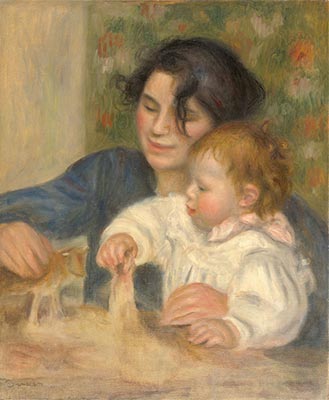
Gabrielle Renard and Infant Son Jean
Beyond his grander masterpieces, Renoir's oeuvre is also marked by a great number of very sweet images of families, often his own wife and three sons, in domestic settings. The softly impressionistic Gabrielle Renard and Infant Son Jean shows his nanny (also his wife's cousin) Gabrielle playing with his son, the future film director Jean Renoir. Jean would publish the biography Renoir, My Father in 1962, in which he illuminated parts of his upbringing and the enormous influence his father had on his artistic career. Much of our most intimate knowledge of Renoir the painter relies on the research and personal anecdotes written down by his son; here, the father portrayed an intimate moment into his son's early life, as he is entertained with a stuffed animal.
Oil on canvas - Musée de l'Orangerie, Paris
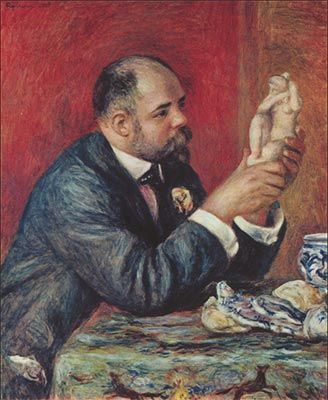
Portrait of Ambroise Vollard
Ambroise Vollard was a dealer, friend, and supporter of Renoir's art in the later stages of the artist's career, even going so far as to publish a biography of the artist in 1925. Renoir celebrated their friendship by painting Vollard many times in many different guises. As a painting, Portrait of Ambroise Vollard, reveals Renoir's considerable abilities as a portraitist, through a delicately rendered image that at once touches upon the more recent artistic experiments of Paul Cézanne (multiple points of view) and Henri Matisse (large planes of color), while retaining Renoir's structure, coloration, and impressionistic application of paint. Moreover, he depicted Vollard as an intelligent connoisseur of art and an admirer of beauty who holds a small, classically inspired sculpted nude. This is particularly poignant in hindsight, as it was Vollard in 1913 who would suggest to the ailing, arthritic Renoir, for whom painting was becoming increasingly difficult, that he consider sculpting, going so far as to locate and provide for the aging artist a young, talented sculptor to help him achieve his designs. In 1908, then, despite his failing health, Portrait of Ambroise Vollard still shows Renoir capable of considerable artistic achievement.
Oil on canvas - The Courtauld Gallery, London
Biography of Pierre-Auguste Renoir
Childhood
Pierre-Auguste Renoir was born into a working-class family in Limoges, a city in the central west region of France. The area is historically significant as the center of French porcelain production, reaching that status during the 19th century. Fittingly, Renoir's first artistic job, during his teens, was as a painter in one of the town's porcelain factories. The son of a tailor and a seamstress, Renoir had a steady hand and a talent for decorative effect, which earned him praise from his employers and brought him to the attention of a growing customer base, including a number of wealthy patrons for whom he painted picture hangings and decorations for fans and other luxury objects. These early successes fed his desire to leave the factory and pursue fine arts painting.
To compensate for the limited training he was receiving in Limoges, in 1860 Renoir began making frequent trips to visit the Louvre in Paris to study the work of the French Rococo masters Jean-Antoine Watteau, Jean-Honore Fragonard, and François Boucher, and the Romantic painter Eugène Delacroix. Though Delacroix and the Rococo painters worked nearly a century apart, Renoir recognized similarities in their soft, loose handling of paint, which showed individual brushstrokes, and their embrace of color and movement rather than the Classical clarity of carefully composed form.
Early Training
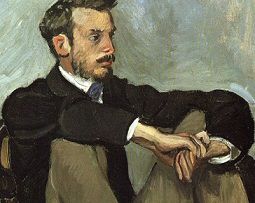
In 1862, Renoir began his formal training under Charles Gleyre, a Swiss-born academic painter who instructed a number of talented painters, among them Claude Monet, Alfred Sisley, and Frédéric Bazille, three of Renoir's future Impressionist colleagues with whom he became close friends upon entering Gleyre's Paris studio.
During their training, Renoir and his new friends would venture into the scenic forest of Fontainebleau to engage in plein air painting. However, unlike Monet and Sisley, Renoir always maintained a penchant for the studio and for painting more traditional portraiture in the style of the 18th-century French masters he so admired. Fontainebleau became a favorite painting spot of Renoir's and one he visited frequently, thanks in part to his friend Jules Le Coeur, an admirer of his art who owned a house in Bourron-Marlotte, a commune on the forest's southern border. In 1865, Le Coeur introduced Renoir to the seventeen-year-old Lise Tréhot, who became Renoir's lover and favorite model for several years. Tréhot sat for dozens of portraits, including two in 1867: Diana the Huntress, which portrayed her as a Greek goddess a la a Rococo portrait, and Lise with a Parasol, which was received favorably at the French Salon of 1868. Well aware of the Salon's strict standards, Renoir executed these portraits in a conventional compositional style, combining smooth lines and meticulous coloration with a matter-of-fact naturalism reminiscent of the Realist painter Gustave Courbet, whom he admired.
During the summer of 1869, Renoir and Monet spent two months painting at La Grenouillère, a lakeside boating resort for the French middle class located just outside of Paris. Indeed, the case can be made that Renoir and Monet sowed the seeds of Impressionism at La Grenouillere. It was here that both men began to use broad brushstrokes to capture momentary scenes with a sketch-like looseness of feel, deftly capturing the water's natural movement and reflective effect on light.
Mature Period
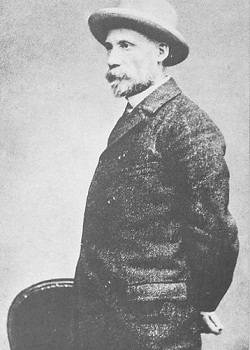
Immediately following the brief but tumultuous Franco-Prussian War (in which Renoir fought) and the occupation of the French Commune in 1871, Renoir's early success began to take a turn for the worse. Rejections from the Salon far outnumbered acceptances, due in no small part to the "unfinished" quality his newer work assumed. His fortunes reached a point where Renoir was faced with the choice of either paying models or buying paint. While others of his colleagues like Claude Monet and Camille Pissarro had ceased to do so, Renoir continued submitting work to the Salon up until 1873, holding on to the belief that acceptance was a necessary yardstick for success. As Petra Chu notes in Nineteenth-Century European Art: "As late as 1881, the Impressionist painter Auguste Renoir wrote to his dealer [Paul] Durand-Ruel: 'In Paris, there are barely fifteen collectors capable of liking a painter without the backing of the Salon. And there are another eighty thousand who won't buy so much as a postcard unless the painter exhibits there.'" In addition, his friendship with the Le Coeur family soured in 1874, leaving Renoir without that source of patronage and the ability to stay in their home near Fontainebleau.
Following the 1873 Salon, in which the Impressionists' canvases were largely panned, Renoir and his cohorts began planning an independent exhibition of their works, free from the aesthetic constraints of the Salon and its jury system. The first Impressionist group show was held on April 15, 1874. While Renoir sold few works as a result of the show, it brought him to the attention of the collector Victor Chocquet, whose portrait he would paint and who would become something of a financial savior during this period.
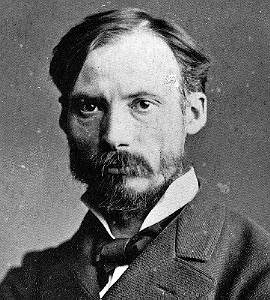
By the time of the fourth Impressionist exhibition in 1878, Renoir quietly abstained. He had discovered financial independence thanks to regular portrait commissions (which in turn led to further success in the Salon) and had become disenchanted with the ideology of spontaneity that he felt had consumed the group. Shortly after disassociating himself from the very group of artists he helped found, Renoir traveled to Italy for the first time, a trip enabled by a financial deal he had struck with the dealer Paul Durand-Ruel. During this sojourn, he came of the opinion that Impressionism lacked the structural underpinnings that had produced the great art of the Renaissance masters like Raphael. As he wrote to the dealer Ambroise Vollard later in his life, "by the early 1880s, he felt that he had 'reached the end of Impressionism, and could neither paint nor draw.'"
This pilgrimage, then, was a motivation for Renoir to move away from the loose, incidental quality of Impressionism toward more Classical ideas of draftsmanship, composition, and modeling. This shift had, to an extent, already begun: Renoir produced the iconic Luncheon of the Boating Party between 1880 and 1881, immediately before leaving France, and it shows an adjustment of his painterly techniques toward greater compositional unity. The focus of his mature work would no longer be exclusively on pioneering new modes of expressing the movement and color of light and nature. Rather, he looked to the coloration of the Rococo and late Renaissance periods, tendencies that were supported by further trips to Italy, Spain, and England.
Late Years and Death
As the turn of the century approached, now married and with three sons (the last born in 1901), Renoir continued to produce work at an impressive rate, despite his continually failing health. An injury to his right arm from a bicycle accident had left him with severe arthritis, and rheumatism plagued his left eye. By 1910, he was mostly relegated to a wheelchair and with bandages around his hands, making painting a great challenge. The family purchased a home in Cagnes-sur-Mer in the south of France, which gave Renoir periodic relief from his pains with its dry and mild climate.
In the previous decade, Renoir had befriended the art dealer Vollard, who became both an important patron and a trusted advisor to the artist when it came to choosing subject matter. In 1913, Vollard, well aware of Renoir's physical limitations, made the bold suggestion that he attempt sculpture, introducing him to the Catalan-born sculptor Richard Guino. Despite his physical ailments, Renoir was able to complete several successful sculptures during his collaboration with Guino, who largely worked with clay.
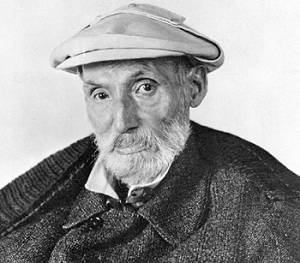
Influenced by his earlier trips to Spain to see the works of Francisco Goya, Renoir infused his late paintings with an increasingly monumental style. While his fellow Impressionists Claude Monet and Edgar Degas pursued the effects of light nearly to the brink of abstraction later in their careers, Renoir gained a solid, almost sculptural quality in the figures and landscapes he painted during the twilight of his career.
In the winter of 1919, Renoir suffered a heart attack at his home in Cagnes-sur-Mer. Shortly after, he passed away on December 3, 1919, with his sons by his side and several of his works hanging in the Louvre among the French masters he once went there to study.
The Legacy of Pierre-Auguste Renoir
It could be argued that Renoir and his colleague Monet are to Impressionism as Pablo Picasso and Georges Braque are to Cubism: their experiments in painting together created an entirely modern visual idiom and marked off the artistic territory that the movement would grow to inhabit in the following decades.
He was also the first among his colleagues to recognize the cul-de-sac that Impressionism presented. Though Paul Cézanne is typically credited for the attempt "to make of Impressionism something solid and lasting like the art of the museums," this crisis in the movement was first met head-on by Renoir. His well-documented reintroduction of composition, outline, and modeling into his painting never completely erased the radical reassessment of color he helped theorize alongside Monet. Ultimately, his combination of modernity and tradition was highly influential on a next generation of artists including Pierre Bonnard, Pablo Picasso, Henri Matisse, and Maurice Denis, all of whom collected his work.
Influences and Connections

-
![Claude Monet]() Claude Monet
Claude Monet -
![Gustave Caillebotte]() Gustave Caillebotte
Gustave Caillebotte ![Victor Chocquet]() Victor Chocquet
Victor Chocquet![Paul Durand-Ruel]() Paul Durand-Ruel
Paul Durand-Ruel
Useful Resources on Pierre-Auguste Renoir
- RenoirOur PickBy Anne Distel
- RenoirBy Peter H. Feist
- Pierre-Auguste RenoirBy Mike Venezia
- Renoir. Painter of HappinessOur PickBy Gilles Néret
- Renoir, My FatherOur PickBy Jean Renoir
- Renoir: An Intimate BiographyBy Barbara Ehrlich White
- Pierre-Auguste Renoir - Paintings, Pastels and DrawingsBy Ambroise Vollard
- Pierre-Auguste RenoirBy Daniel Ankele and Denise Ankele
- 924 Color Paintings of Pierre-Auguste RenoirOur PickBy Jacek Michalak
- Renoir: IntimacyOur PickBy Colin B. Bailey and Flavie Durand-Ruel
- Renoir: The Body, The SensesOur PickBy Esther Bell and George T. M. Shackelford
- The Great Book of French ImpressionismBy Diane Kelder
- Renoir and Friends: Luncheon of the Boating PartyBy Eliza E. Rathbone
- Renoir Landscapes: 1865-1883By Colin Bailey, Christopher Riopelle, and John House
 Ask The Art Story AI
Ask The Art Story AI